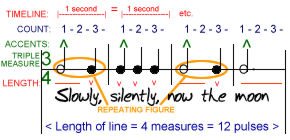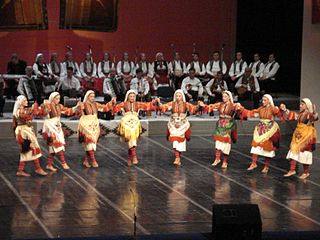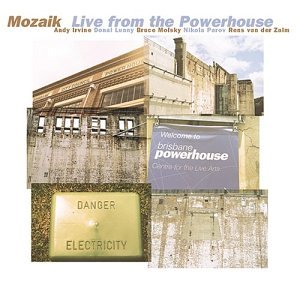Related Research Articles
A time signature is a convention in Western music notation that specifies how many note values of a particular type are contained in each measure (bar). The time signature indicates the meter of a musical movement.
In musical terminology, tempo also known as beats per minute, is the speed or pace of a given composition. In classical music, tempo is typically indicated with an instruction at the start of a piece and is usually measured in beats per minute (BPM). In modern classical compositions, a "metronome mark" in beats per minute may supplement or replace the normal tempo marking, while in modern genres like electronic dance music, tempo will typically simply be stated in BPM.

In music, metre or meter refers to regularly recurring patterns and accents such as bars and beats. Unlike rhythm, metric onsets are not necessarily sounded, but are nevertheless implied by the performer and expected by the listener.

The music of Bulgaria refers to all forms of music associated with the country of Bulgaria, including classical, folk, popular music, and other forms.

Hora, also known as horo and oro, is a type of circle dance originating in Aromanian and Romanian communities, especially in Romania and Moldova. It is also found in other South East European countries and culturally adopted by ethnic minorities such as the Ashkenazi Jews and the Roma.
The music of Thrace, a region in Southeastern Europe spread over southern Bulgaria, northeastern Greece, and European Turkey, contains a written history that extends back to the antiquity, when Orpheus became a legendary musician and lived close to Olympus. Though the Thracian people were eventually assimilated by surrounding Balkan groups, elements of Thracian folk music continue.

Bulgarian folk dances are intimately related to the music of Bulgaria. This distinctive feature of Balkan folk music is the asymmetrical meter, built up around various combinations of 'quick' and 'slow' beats. The music, in Western musical notation, is often described using compound meter notation, where the notational meter accents, i.e., the heard beats, can be of different lengths, usually 1, 2, 3, or 4. Many Bulgarian dances are line dances, in which the dancers dance in a straight or curved line, holding hands.
Leventikos ; or Bufčansko, also known as Litós (Λιτός), Kucano, Nešo or Pusteno, is a dance of western Macedonia, mainly performed by ethnic Macedonians and Greeks in the town of Florina, Greece and in the Resen and Bitola regions in the neighbouring North Macedonia.
Zonaradiko is a traditional Greek folk dance from Thrace (Greece) that is named after the dance's handhold. Dancers hold the adjacent dancer's zonaria (belt) during the dance. Zonaradiko is a village line dance done in one form or another all over Greece. In each village the dance will look somewhat different, but the basic structure is essentially the same. The same dance is done in Bulgaria under the name Pravo. The variations below are a collection of steps commonly done by folk dancers throughout the US and as seen done by various groups in Greece.
Greek traditional music includes a variety of Greek styles played by ethnic Greeks in Greece, Cyprus, Australia, the United States and other parts of Europe. Apart from the common music found generally in Greece, each region of Greece contains a distinct type of folk music that originated from the region due to their history, traditions and cultural influences.
Gankino horo is a Bulgarian folk dance written in 11 (undecuple) = 2+2+3+2+2 time similar to kopanitsa or krivo horo. The name gankino seems to be used mostly in northern Bulgaria. The basic gankino horo is a three-measure dance using the step structure also common in the dances: Dunavsko, Povarnoto and Eleno Mome.
Yove male mome, also called Povela e Yova, is a fast Bulgarian folk dance. It is done to a 7+11
16 = 18
16 compound meter with alternating (sub-)bars of 7+11, in their turn divided into common chetvorno and kopanitsa rhythms. Some dancers count it as 3-2-2, 2-2-3-2-2 or SQQ-QQSQQ, "S" meaning "slow", and "Q" meaning "quick". It originates from the traditional dance Jove from the Shopluk region of Bulgaria.
Dajchovo horo is a Bulgarian folk dance done to a nine-beat meter. It is unique in two ways: it is a circle dance, and yet it has a leader.
Pravo horo is a very popular, simple folk dance from Bulgaria that is done throughout the Balkan countries. In Greece, it is called Zonaradiko. It is considered the "national dance" of Bulgaria, Albania, and North Macedonia. It is a rustic village line dance with a three-measure pattern, done to 2
4 or 6
8 music, and is a staple of weddings, feast days, and other celebrations. As with other Balkan dances, each country and even local region has its own variation of the dance, often interspersing other steps with the basic pravo step, to the extent that these different versions amount to distinct dances.
Lesnoto, or Lesno, is the name of a family of simple, popular folk dances from North Macedonia, also done in Bulgaria and parts of neighboring Balkan countries. It is a line dance, usually done to a seven-beat meter organized in a slow, quick, quick rhythm, often abbreviated 3+2+2. The common factor of all the forms is a pattern of "three steps to the right, one step to the left". These are probably the most common dances in the region, done at parties and mehanas (cafés) to both traditional and modern music.

After The Break is the fourth studio album by the Irish folk music band Planxty, recorded at Windmill Lane Studios from 18 to 30 June 1979 and released the same year. It was the band's first of two releases on Tara Records.

EastWind is an album by Andy Irvine and Davy Spillane, showcasing a fusion of Irish folk music with traditional Bulgarian and Macedonian music. Produced by Irvine and Bill Whelan, who also contributed keyboards and piano, it was widely regarded as revolutionary at recording.

Live from the Powerhouse is an album rehearsed in six days, starting on 1 March 2002 in the seaside town of Rye, Victoria in Australia, by multicultural group Mozaik featuring Andy Irvine, Dónal Lunny, Bruce Molsky, Nikola Parov and Rens van der Zalm.

Between the Jigs and the Reels: A Retrospective is a two-disc anthology by the Irish folk band Planxty. It includes a 17-track CD and a 36-track DVD with over two hours of previously unreleased footage (1972–1982) from RTÉ archives.
References
- ↑ Barber E. W. The Dancing Goddesses: Folklore, Archaeology, and the Origins of European Dance. W. W. Norton & Company, 2013. ISBN 0393089215, 9780393089219 Accessed at Google Books 27 September 2015.
- ↑ Antokoletz A. E. et al. (ed.)Bartok Perspectives : Man, Composer, and Ethnomusicologist. Oxford University Press, USA, 2000 p. 205 ISBN 019977112X, 9780199771127.
- ↑ Dick Oakes master teacher biographies. Phantom Ranch website.